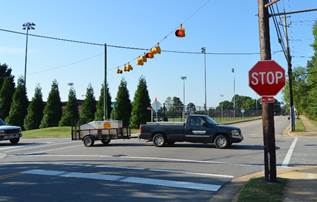
Users of Unsignalized Intersections
Throughout the UIIG, reference is made to “users” of unsignalized intersections. In general, any individual who traverses an unsignalized intersection can be cast into one of three primary groups:
-
Motor vehicle operators. Since roads are built primarily to carry motor vehicles from their origin to their destination, they represent the vast majority of intersection users. Motor vehicles include passenger vehicles, mopeds, motorcycles, trucks, buses, and recreational vehicles, all of which come in many sizes. The design and operation of the intersection must account for the physical and operational characteristics of these vehicles. Most significant are their length and turning radius capability. Longer vehicles—especially large trucks—require a larger curb radius to safely turn at an intersection without encroaching on the curb and beyond or into the opposing lane. Heavier vehicles require longer distances for braking and accelerating, which can influence the design of the intersection. Buses (local transit and school buses) represent a special case as they both travel through the intersection and stop at intersections to board and discharge passengers. The majority of the treatments presented in the UIIG targets drivers of motor vehicles.

Source: VHB.
- Bicyclists. Whether for pleasure, exercise, a mode to work, or other uses, bicycle travel is increasing in the U.S. Bicyclists can be accommodated through separate off-road paths, bike lanes or paved shoulders along the road, or as part of the main traffic stream by sharing a travel lane with motor vehicles. When traveling on a roadway through an unsignalized intersection, bicyclists must adhere to the same rules of the road that apply to motor vehicles. The primary safety issue confronting bicyclists at intersections is that they can be difficult to detect by motorists who are quickly scanning the area to identify any number of potential risks. Being smaller in size than motor vehicles and tending to position themselves along the outside edge of the roadway instead of the center of the travel lane, bicyclists are not as readily seen by drivers of motor vehicles—particularly drivers executing turning maneuvers. Specific information on bicyclist accommodations can be found in the following FHWA resources:

Source: VHB.
- Bicycle Countermeasure Selection System (BIKESAFE)—a website that provides the latest information available for improving the safety and mobility of those who bicycle.
- Bicycle Road Safety Audit Guidelines and Prompt Lists—a document that explains how to conduct a road safety audit focused on safety issues for bicyclists.
- Non-Motorized User Safety: A Manual for Local Rural Road Owners—a manual that describes a process to address the safety of non-motorized users on low-volume rural roadways.
Additionally, the American Association of State Highway and Transportation Officials (AASHTO) Guide for the Development of Bicycle Facilities provides guidance on the design of bicycle facilities, but this publication is available only in hardcopy form through the AASHTO website.
- Pedestrians. Depending upon the surrounding land use and the presence or absence of bus stops, there can be significant numbers of pedestrians who cross at unsignalized intersections. Pedestrians have different abilities, levels of experience, and walking speeds. Crossing an unsignalized intersection as a pedestrian is done without the aid of a traffic signal and, therefore, can be at a higher risk for this user group. The subset of pedestrians who are particularly vulnerable includes children (who may be crossing without a crossing guard), seniors (who tend to walk at slower speeds than the general population), and persons with disabilities (who may use a wheelchair, be visually impaired, or have other disabilities). There are several UIIG treatments that address the needs of all pedestrian types.

Source: Lee Engineering, LLC.
Additional information can be found in the Pedestrian Safety Guide and Countermeasure System (PEDSAFE), which provides the latest information available on engineering, enforcement, and education treatments to improve pedestrian safety and mobility based on user input about a specific location. See also the UIIG’s ADA and Pedestrian Considerations for information on how persons with disabilities are to be accommodated at unsignalized intersections.

